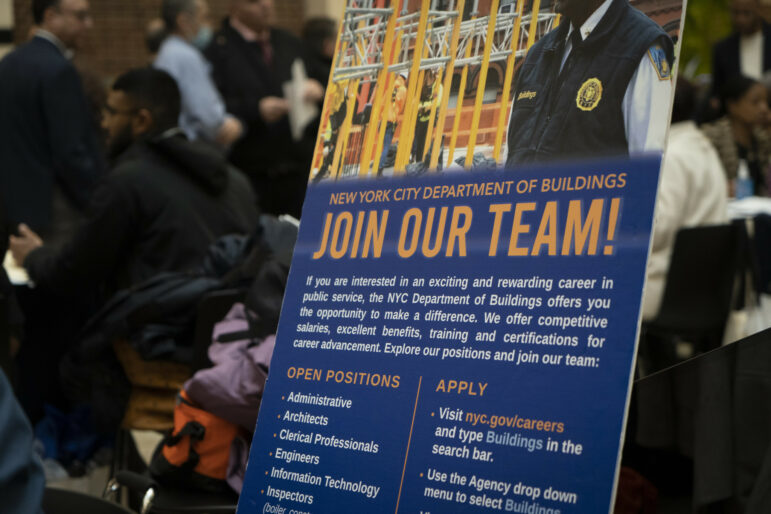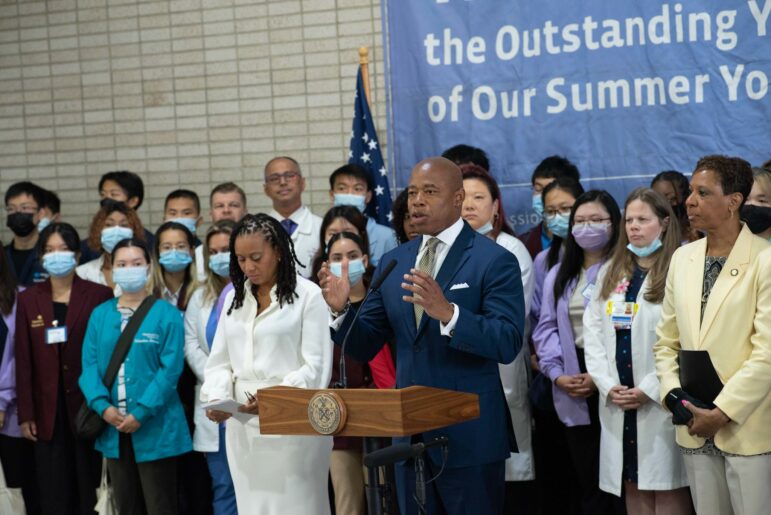While New Yorkers are on the rebound from job loss due to the COVID-19 pandemic, unemployment rates in NYCHA continue to plague residents, particularly among Black and Latino men, a new report finds.

NYC Mayor’s Office/Caroline Willis
A jobs fair for city agencies in March.While New Yorkers are on the rebound from job loss due to the COVID-19 pandemic, unemployment rates in NYCHA continue to plague residents, particularly among Black and Latino men, a new report finds.
The housing authority overall has a smaller number of tenants who are unemployed compared to residents in other low-income households, according to the Community Society of New York, or CSS (disclosure: CSS is a City Limits funder).
About 20 percent of NYCHA residents reported being unemployed—which includes those who are actively looking for work, and those who aren’t—versus an estimated 25 percent of non-NYCHA tenants in low income housing, according to the analysis, based CSS’ annual survey of low-income households conducted in 2022, called “The Unheard Third.”
Within NYCHA, the unemployment rates among Black and Latino men were higher than any other population group, with 18 percent of Black men and 16 percent of Latino men seeking job opportunities who have yet to find work, and an additional 7 percent of respondents in both groups who said they were unemployed but not looking.
Compared to other racial groups, Latino adults in NYCHA were most likely to be job hunting and unemployed, at 17.6 percent, the survey found. However, Black men, who are “considerably younger” than the rest of the NYCHA population, make up the highest percentage of unemployed NYCHA tenants overall, regardless of whether or not they are looking for a job.
The Center for New York City Affairs, a social policy institute at The New School, conducted a similar survey which showed that despite the city seeing an overall decline in unemployment rates—5.3 percent in the first quarter of 2023 down from 6.4 percent the first quarter of last year—unemployment rates rose for Black workers.
Furthermore, young New Yorkers between the ages of 18 and 24 struggle to find work and have an unemployment rate of 17 percent.
More summer jobs
Among the the report’s suggestions for boosting work numbers is to grow the city’s Summer Youth Employment Program (SYEP), which since 1963 has hired New Yorkers between the ages of 14 and 24 for a variety of jobs each year.
For the second consecutive year last summer, 100,000 SYEP jobs were made available as part of Mayor Adams’ Blueprint to end Gun Violence, the largest number of positions available since the program’s inception.
Jobs First NYC, a nonprofit organization cited in the CSS report, found that New Yorkers between the ages of 18 and 24 were 35 percent more likely to experience job loss during the pandemic compared to other age groups.
The study suggested that youth of color who are leaving school before completion and a drop in community college enrollment are contributing to the youth unemployment rate. According to a 2022 story from The City, community college enrollment declined citywide by 13.2 last year compared to the year before.
Roughly 167,000 applications were submitted last year for SYEP, according to reporting in March by Chalkbeat, with positions assigned through a lottery system. Retail, childcare, tourism, and health care were among the jobs offered, according to the article. SYEP is often a participant’s first foray into the job market; participants are offered minimum wage of $15 an hour.
An estimated 18,300 of last year’s SYEP applicants were NYCHA residents—55 percent of whom were not picked through the random selection process, according to the CSS report, which calls on the city to further grow the program so more young people can take part.

Michael Appleton/Mayoral Photography Office
Mayor Adams at a kickoff event for the city’s Summer Youth Employment Program (SYEP) last year.Stop and frisk numbers
CSS attributed the employment disparity for Black men at NYCHA to several factors, including the lack of public jobs to resurface after the height of COVID and past involvement in the criminal justice system.
“Any conversation about joblessness and race cannot be complete without considering the role discrimination and mass incarceration play,” the report notes.
Last year, the 27 police precincts that had at least 5 NYCHA developments in their area made up half of all stop and frisks performed by police, according to the CSS report—122 percent higher than precincts with zero developments in their area.
According to 2022 NYPD data cited, of more than 15,000 so-called “Terry Stops” performed by police, 60 percent were carried out against Black men and 30 percent to Latino men. Despite the city seeing some of the sharpest declines of incarceration rates in the nation due to measures such as the Criminal Justice Reform Act of 2016, bail reform in 2019 and the legalization of marijuana in 2021, the number of Black New Yorkers in custody rose.
Between April 2018 and April 2023, there was a 68 percent decrease in the number of individuals behind bars but at the same time, the number of Black New Yorkers in custody rose from 55 to 60 percent, CSS found.
Employment opportunities at NYCHA
To promote economic growth, the Department of Housing and Urban Development (HUD) implemented Section 3 which would—through contractors and subcontractors—provide employment and training opportunities for low-income residents.
In NYCHA, the Office of Resident Economic Empowerment and Stability (REES) provides services such as vocational training. Other work opportunities include the NYCHA Resident Training Academy (NRTA) which teaches residents skills such as asbestos abatement, carpentry, painting and plumbing. After completion, participants receive a certificate and can be offered jobs with NYCHA contractors for up to one year.
Between 2016 and 2020, 6,160 residents were hired by NYCHA, according to a figure cited by CSS through NY Focus. Resident hires have dropped over the last few years, despite ramped up construction at NYCHA, falling to 22 percent in 2020 (the benchmark goal is 30 percent). Just 8 percent of those hired to work on NYCHA’s capital construction projects that year were hired under Section 3, the report found.
In April, RDC Development Company—one of the partner teams in NYCHA’s Permanent Affordability Commitment Together (PACT) program—hired 55 tenants through Section 3 at Williamsburg Houses in Brooklyn. Similarly at St. Nicholas Houses in Central Harlem, The Occupational Health and Safety Administration (OSHA) has a 30-hour construction training course with 10-hour onsite safety training, EPA Lead Renovation as well as a Repair and Painting Certification Program (RRP) without any cost to residents.
Beyond hiring within the authority, NYCHA runs several initiatives to encouraging entrepreneurship among residents. REES, for example, launched the Business Pathways program in 2015 to support entrepreneurs in the catering and childcare industries. Earlier this year, Speaker Adrienne Adams proposed expanding the pathways program to other fields of work, including carpentry.
New programs such as NYC Boss Up, which launched in March, offer opportunities for NYCHA residents to earn up to $20,000 for their business while learning more about operations, financial stability and growth.
CSS suggests that efforts to strengthen reentry programs and desegregation in schools and neighborhoods can help eliminate the employment gap. Promoting and expanding existing programs, such as the initiatives offered by Section 3, can also help address the disparities.








